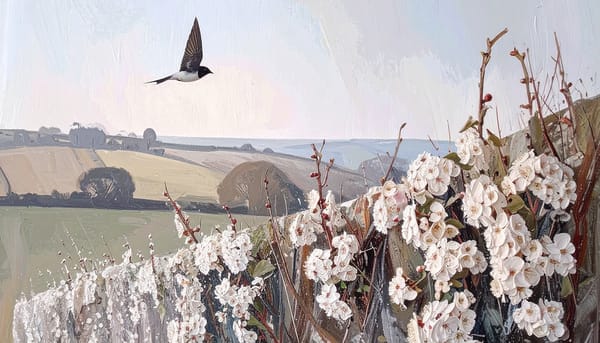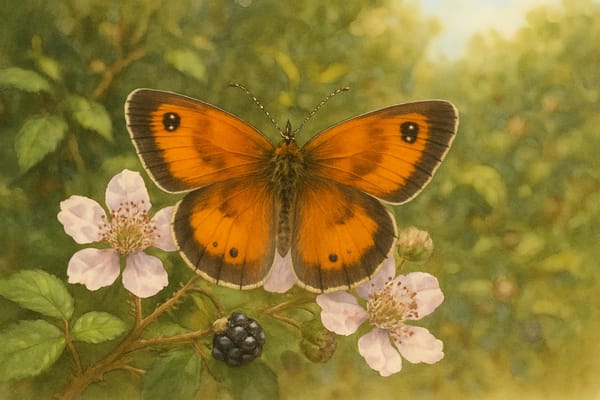Across Cornwall, the first signs of spring aren’t found in almanacs or weather charts, but in hedgerows of blossoming blackthorn, the shimmer of frogspawn in a rain-fed pond, or the soft arrival of swallows above sun-warmed fields. This is the living language of the land — a phenological rhythm passed down not by ink, but by instinct.
Phenology — the study of nature’s seasonal life cycles — offers a powerful way to understand how Cornwall’s environment responds to subtle shifts in climate, land use, and human influence. These aren’t just quaint observations; they are vital signs in a landscape where change is unfolding with increasing urgency.
In the past, Cornish farmers, fishermen, and gardeners marked the seasons by instinctive cues: the fall of oak leaves signaling the end of harvest; the arrival of martins heralding warm weather for planting; the first bluebell a soft echo of longer, lighter days. Now, citizen science projects like Nature’s Calendar collect these observations in data form — revealing patterns that confirm what many gardeners and nature-lovers have suspected: Cornwall’s living almanac is changing.
Shifting Seasons, Changing Clocks
In Cornwall’s mild maritime climate — softened by the Gulf Stream’s warm currents — spring now arrives earlier, autumn lingers longer, and familiar cycles shift. Frogspawn appears weeks ahead of historic averages, buds burst early on hawthorn and elder, and bluebells bloom before pollinators emerge. Across the UK, many plants now flower a month earlier than they did fifty years ago, and Cornwall, with its long growing seasons, often leads this trend.
Yet not all changes are benign. These shifts create ecological mismatches. Tadpoles born too soon may perish in late frosts. Flowers bloom without their pollinators. Migrating birds arrive after insect numbers have peaked. Across Cornwall’s hedges and pastures, these unseen misalignments ripple through the web of life.
A Landscape of Hope and Warning
Cornwall’s distinctive phenological profile — earlier flowering, longer growing seasons — isn’t just about weather. It reflects a complex weave of climate change, fragmented habitats, and changing land practices. Coastal towns see plants blooming earlier than inland moors. Urban gardens heat up sooner than rural ones. Even the hedgerows and field margins, rich in biodiversity, have lost nearly 40% of their characteristic species range since the late 1980s.
Yet Cornwall is also a beacon of resilience. From the Nature Recovery Strategy aiming to protect 30% of land by 2030, to community-led wildlife corridors and habitat restoration, efforts to reverse decline are gaining ground. Across Devon and Cornwall, over 390,000 trees have been planted, and rare marine habitats like maerl beds are receiving new protections.
The Gulf Stream’s Signature
Cornwall’s climate owes much to the Atlantic’s Gulf Stream — a silent sculptor of the landscape. This oceanic warmth gifts the county its rare floral diversity, supports early blooms of magnolia and camellia, and allows subtropical species like echiums and agapanthus to thrive. Coastal valleys often feel five degrees warmer than inland, shaping everything from spring leaf-out to the success of vineyards and tea gardens.
But this gift comes with challenges. Warmer winters make Cornwall a hotspot for invasive species and climate-driven diseases. Subtropical plants may flourish, but so too may pests and pathogens. As gardeners, there’s a delicate balance between embracing opportunity and safeguarding Cornwall’s living heritage.
A Garden Almanac of Your Own
In the face of shifting seasons, one of the most powerful acts a gardener or nature-lover can take is to observe — and record. Keep a simple nature journal. Note the first swallow, the bloom of snowdrops, the gold fade of oak leaves. Contribute your sightings to projects like Nature’s Calendar, adding your voice to a growing community of citizen scientists helping map Cornwall’s changing story.
Plant with resilience in mind. Choose native species that support pollinators and wildlife, and plan for longer bloom times. Work with nature, allowing wild edges, berrying shrubs, and meadow patches to thrive in your garden.
Reading the Signs of Change
Cornwall’s living almanac isn’t fixed. It is a story written in petals, wings, and tides — one that reflects both the richness of its natural beauty and the reality of a changing climate.
By tuning into these signs, we not only deepen our relationship with the landscape but become stewards of its future. In a time when change feels fast and often overwhelming, perhaps the most powerful response is to slow down, watch closely, and honour the unfolding story of Cornwall’s living land.
E









